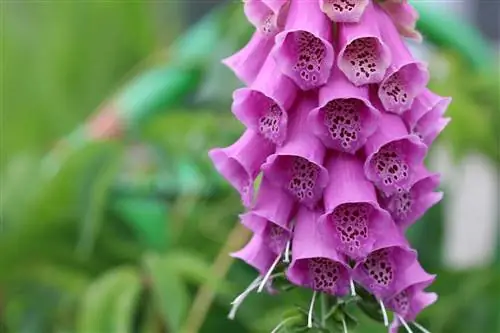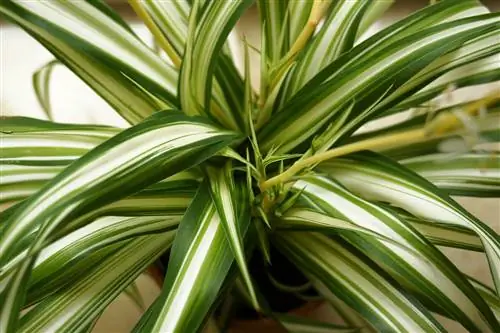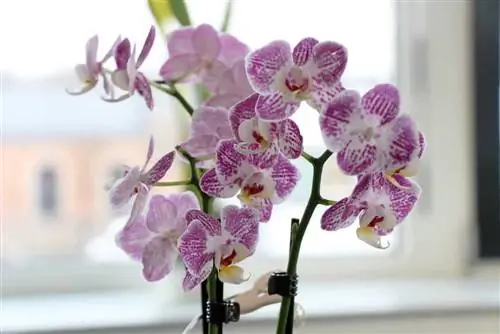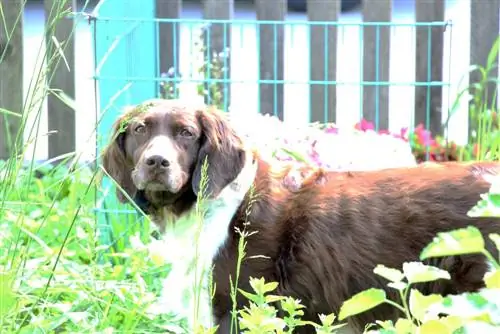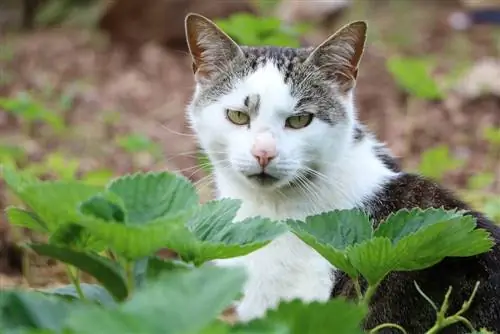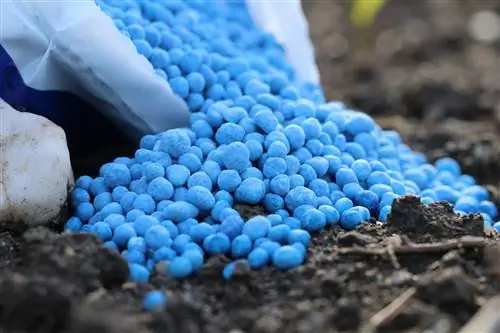- Author admin [email protected].
- Public 2023-12-17 03:39.
- Last modified 2025-06-01 06:48.
With the first warm rays of sunshine, Mother Nature awakens and sets the first colorful accents in the garden with her signs of spring. However, if you share your garden with dogs, cats, etc., you should avoid some plants. No matter how beautiful they look, flowers and plants sometimes contain toxic ingredients that can cause irritation and serious symptoms of poisoning. But which plants are dangerous and what can you do to help your beloved four-legged friend immediately?
Poisonous beauties in the garden
Plants protect themselves from being eaten with unpleasant smells, a bitter taste or prickly thorns. But playfulness and curiosity often lead animals to nibble on poisonous plants. Because they cannot distinguish between what is good and what is bad. Some house plants are already a potential source of danger. Whether the parrot pecks at the aloe vera or the cat sharpens its claws on the rubber tree - toxic substances lurk in many beauties. Among other things, in poisonous ornamental plants:
Adonis Roses
- all plant parts
- contains toxic substances such as cardiac glycosides
- general symptoms of poisoning (see below) and cardiac arrhythmias possible
Aloe Vera
- especially leaves
- Ingested orally, the ingredient saponin causes irritation in the mouth and throat, as well as the digestive tract
- strong laxative effect
- Irritation of the kidneys
- Symptoms of paralysis and cramps
Amaryllis family
- onions are poisonous
- Amaryllis plants such as snowdrops or knight's star are dangerous for dogs, cats, guinea pigs and hamsters
- Onions contain the poison lycorine in high doses
- general symptoms of poisoning
Azalea
- Flower nectar and leaves
- initially cause a burning feeling in the mouth
- general symptoms of intoxication, irregular heartbeat, muscle weakness and loss of vision occur later
Boxwood
- all plant parts
- contains various alkaloids
- general symptoms of poisoning
Christ Thorn
- Milk juice
- contains ingenol esters that irritate skin and mucous membranes
- causes increased salivation and stomach cramps
- Visual disturbances are possible if it comes into contact with the eyes
Christmas Rose
- Roots and seed pods
- contains toxic substances such as hellbrin, saponins and protoanemonin
- general symptoms of poisoning
Yew
- Seeds and needles very poisonous
- contains different alkaloids
- general symptoms of poisoning
- Circulation collapses and breathing is paralyzed
Angel Trumpet
- all parts of the plant, especially roots and seeds, are highly poisonous
- contains poisons such as atropine, hyoscyamine and scopolamine
- general symptoms of poisoning
- Difficulty breathing up to circulatory and respiratory arrest
Ivy
- Stems, leaves and sap of the plant
- The bitter-tasting berries are highly poisonous
- not only pets, also grazing animals at risk
- irritate mucous membranes
- general symptoms of poisoning
- Consumption often leads to death from cardiac arrest
Foxglove
- all plant parts
- contains high doses of toxic digitaloids
- deadly in small quantities due to cardiac arrest
- general symptoms of poisoning
- severe cardiac arrhythmias
Broom
- Seeds and leaves are considered highly poisonous
- contains the toxic alkaloid sparteine
- toxic to domestic and pasture animals
- general symptoms of poisoning
- Constipation and even intestinal obstruction are also possible
Gold Rain
- ripe seeds
- contain different quinolizine alkaloids
- dogs usually vomit immediately
- general symptoms of poisoning
Autumn Crocus
- all parts of the plant highly poisonous
- contains the main toxin colchicine
- initially stimulating and then paralyzing
- general symptoms of poisoning up to cardiovascular failure
hydrangea
- Flowers in particular are poisonous - even after drying
- contains toxic ingredients such as saponins and hydrogen cyanide
- general symptoms of poisoning
Hyacinth
- all parts of the plant
- contains calcium oxalates, which damage the mucous membranes in the mouth and throat
- general symptoms of poisoning
Cherry and ornamental laurel
- especially seeds and leaves
- Flesh almost poison-free
- contains glycosides as a plant poison
- general symptoms of poisoning
- severe poisoning causes respiratory paralysis
crocus
- Bulbs and stigmas dangerous for pets and grazing animals
- contains the toxic substance picrococin, which is broken down in safranal.
- can be fatal to rabbits
- general symptoms of poisoning
Lily of the valley
- all parts, especially fruits and flowers
- contain glycosides
- general symptoms of poisoning
- Cardiac arrhythmias and, in the worst case, cardiac arrest
Oleander
- all plant parts
- contains toxic glycosides nerioside and oleandrin
- irritation in the stomach and intestines, restlessness occurs
- Heart rate drops, heart failure possible
Pfaffenhütchen
- all plant parts
- Seeds in particular contain steroid glycosides
- general symptoms of poisoning
Snowdrops
- the onion is poisonous
- contains different alkaloids
- general symptoms of poisoning
Deadly Nightshade
- especially the berries
- toxic ingredients are hyoscyamine, belladonnan, apoatropin, scopoletin and scopolamine
- Poisoning is shown by aggressiveness, dilated pupils, increased thirst, restlessness, racing heart
- Shortness of breath and respiratory paralysis are also possible
Tulips
- every part of the plant
- contains tuliposides, which irritate mucous membranes
- general symptoms of poisoning
Poisonous Crops
Not only ornamental plants, but also some useful plants are dangerous for our beloved four-legged friends. The toxic effects of different crops can sometimes be life-threatening for cats, dogs, etc. The most famous among them are:
Avocado
- Flesh and kernel toxic to grazing animals and pets
- contains the deadly toxic substance Persin
- Poisoning leads to death
- not treatable
Wild garlic and garlic
- easy to confuse with the leaves of the autumn crocus
- particularly toxic to rodents and horses
- contain toxic alliin
- general symptoms of poisoning
- Circulation disorders, circulatory problems
Beans
- contains toxalbumins (poisonous protein compounds)
- Main active ingredient Phasin
- particularly dangerous for rodents and grazing animals, as well as pigs
- general symptoms of poisoning
potato plant
- aboveground parts of plants
- Herb contains the toxic substance solanine
- this also increases in green and sprouting potatoes
- general symptoms of poisoning
- sometimes the red blood cells break down
Tomato plants
- Tomato herb and unripe fruits contain solanine and atropine
- in addition to general symptoms of poisoning, they also cause inflammation of the mucous membranes in animals
Walnut
- fruit peels are poisonous
- the fungus they contain acts like a neurotoxin
- leads to instant death
Onions
- toxic to dogs and cats in any form
- Ingredients destroy red blood cells, which can lead to anemia
Tip:
Watering water is particularly appealing for your beloved four-legged friends. If this is enriched with fertilizer, dogs and cats should be kept away when watering the garden plants.
Symptoms of poisoning
If poisonous plant parts have been ingested by their beloved pets, owners can recognize this by the following signs:
- increased salivation
- Vomiting
- Diarrhea
- painful stomach cramps
- uncontrolled body control such as shaking or staggering
- difficulty breathing
- decreasing sympathy up to lethargy
- Dilation or constriction of the pupils
First aid measures
Despite all caution, it can happen again and again that dogs, cats etc. dig up flower bulbs or nibble on poisonous plant parts. Here the initial care looks like this:
- Take leftovers out of your mouth and rinse thoroughly with water
- Rinse body parts that have come into contact with poisonous plant parts too
- Watching animals
- If the above-mentioned symptoms of poisoning appear, the veterinarian should be informed and consulted
- If there are any leftovers, take them with you to identify the plant
Frequently asked questions
Can pets eat grapes?
Grapes are harmful to pets both in fresh and dried form. The oxalic acid it contains can lead to acute kidney failure.
Are stone fruit seeds harmful?
The seeds of all types of stone fruit should be taboo for dogs and cats. They contain poisons from which hydrogen cyanide is released in the animal's organism and cell division is blocked. The result is typical symptoms of poisoning that can lead to death.
Things to know about poisonous flowers in brief
Quite a few “poisonous beauties” are at home in our local flower pots and gardens. Many of them are even extremely popular. Some of the most famous poisonous flowers in our gardens and living rooms are:
- lily of the valley,
- the snowdrop,
- the delphinium,
- the thimble,
- the golden shower,
- Oleander,
- the autumn crocus,
- the cup primrose
- and the belladonna lily.
The poisonous flowers in our home or garden pose the greatest danger to small children. After all, they are always tempted to put everything in their mouth or try it. And most poisonous flowers look enticingly colorful and exude a pleasant scent. That's why it's important, especially with small children, to pay close attention to which flower they pick from the meadow! But many adults rarely know exactly which plants are poisonous and what a plant's poison can do.
Example: Golden shower
The laburnum, for example, is a beautiful shrub that makes every garden shine with its bright yellow flowers. But as beautiful as the golden shower is, it is also dangerous. When ripe, the seeds of this shrub are reminiscent of beans in shape. And this part of the plant is also the most poisonous. Even small amounts of the substance it contains can cause nausea, vomiting and tremors. There are even cases where ingesting parts of the plant has resulted in death. In these cases, respiratory paralysis or total circulatory failure occurred.
Example: Foxglove
Another beautiful, yet poisonous resident of our gardens is the foxglove. And most people also know that foxgloves are poisonous. But very few people know exactly how poisonous it is. There are of course different types of thimbles. They differ in the shape of the flowers, stems and leaves. However, all foxglove species have one thing in common: they are all highly poisonous. Even small amounts of foxglove poison can cause nausea and vomiting. This condition can last for several days. Even worse, however, are the consequences that the poison has on the heart and circulation. The pulse falls continuously (down to 20 beats per minute) while the blood pressure rises. Cardiac arrhythmias occur and this can even lead to cardiac arrest, i.e. death.
Example: cup primrose
The cup primrose is one of the most poisonous houseplants. It is not for nothing that it has the appropriate nickname: poison primrose! If you have small children or pets, you might want to avoid putting this flower in your home. The cup primrose has small glandular hairs on its stems through which it secretes a poisonous secretion. That's why you should be particularly careful when removing wilted leaves, for example, and avoid contact with skin. If this toxic secretion comes into contact with the skin, it can cause irritation, swelling, itching, blistering and pain. The symptoms actually get worse every time you come into contact with the secretion.

